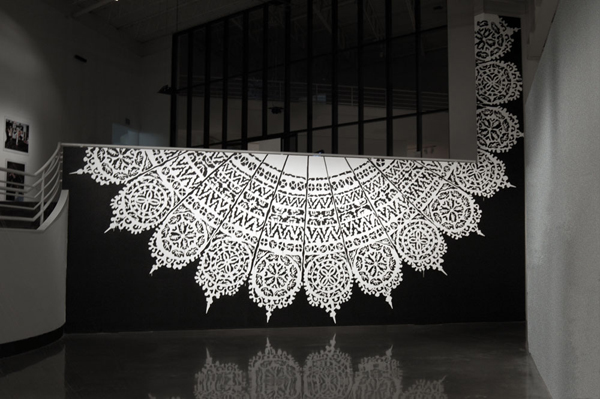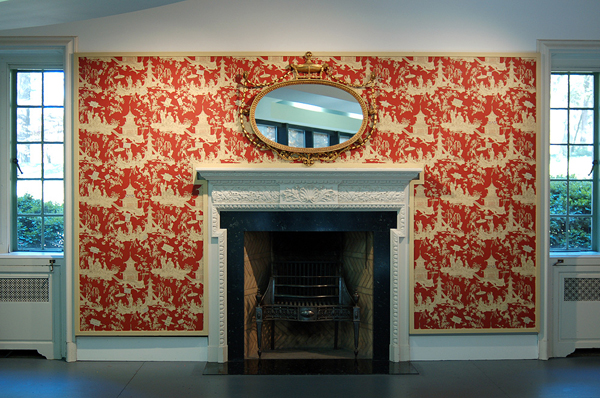 By Sea II, a new project by R. Brooke Priddy in collaboration with Lauren Adams for the ‘Out of Fashion’ exhibition at the South Eastern Center for Contemporary Art in Winston-Salem, NC.
Adams designed the pattern for the floating figure, based upon the 19th century Great Hunt Wallpaper found in the historic Hanes Home at SECCA. The pattern was silk-screened onto spandex in Asheville, NC.
November 3, 2011 – March 10, 2012
By Sea II, a new project by R. Brooke Priddy in collaboration with Lauren Adams for the ‘Out of Fashion’ exhibition at the South Eastern Center for Contemporary Art in Winston-Salem, NC.
Adams designed the pattern for the floating figure, based upon the 19th century Great Hunt Wallpaper found in the historic Hanes Home at SECCA. The pattern was silk-screened onto spandex in Asheville, NC.
November 3, 2011 – March 10, 2012
 ]]>
]]>
Month: November 2011
Two New Commissions for Southeastern Center for Contemporary Art, Winston-Salem, NC
[caption id="attachment_162" align="alignnone" width="600" caption="All My Possessions for a Moment of Time, paint, 2011, 35' x 15'"] [/caption]
All My Possessions for a Moment of Time revives a portrait painting of Queen Elizabeth I, entitled THE ARMADA PORTRAIT (three original versions from the 1500’s, most notably by George Gower), which documents in an allegorical and symbolic context one of the most well-known stories from the Elizabethan Era. Nestled within the appropriated lace collar of Queen Elizabeth, the silhouettes of Algonquins (as presented in Theodore de Bry and Thomas Hariots “A Brief and True Report of the New Found Land of Virginia “, 1588) stretch into another kind of lace-like pattern, forming an all-over impression that reads quite differently to the viewer depending upon their distance from the painting. Drawing upon strategies of pattern and ornament, and the malleable possibilities of form and shape, this piece is part of an ongoing inquiry in an exploratory series of paintings and drawings that lift, excise, and appropriate the found figures and clothing forms from the historical documents, hopefully creating charged absurdities that reflect the legacy of historical inequity in a contemporary visual language.
The title is inspired by a poem written by Queen Elizabeth I.
See the video of the live on-air interview with Lauren here: WXII Television Interview
[caption id="attachment_165" align="alignnone" width="600" caption="Chinoiserie"]
[/caption]
All My Possessions for a Moment of Time revives a portrait painting of Queen Elizabeth I, entitled THE ARMADA PORTRAIT (three original versions from the 1500’s, most notably by George Gower), which documents in an allegorical and symbolic context one of the most well-known stories from the Elizabethan Era. Nestled within the appropriated lace collar of Queen Elizabeth, the silhouettes of Algonquins (as presented in Theodore de Bry and Thomas Hariots “A Brief and True Report of the New Found Land of Virginia “, 1588) stretch into another kind of lace-like pattern, forming an all-over impression that reads quite differently to the viewer depending upon their distance from the painting. Drawing upon strategies of pattern and ornament, and the malleable possibilities of form and shape, this piece is part of an ongoing inquiry in an exploratory series of paintings and drawings that lift, excise, and appropriate the found figures and clothing forms from the historical documents, hopefully creating charged absurdities that reflect the legacy of historical inequity in a contemporary visual language.
The title is inspired by a poem written by Queen Elizabeth I.
See the video of the live on-air interview with Lauren here: WXII Television Interview
[caption id="attachment_165" align="alignnone" width="600" caption="Chinoiserie"] [/caption]
Chinoiserie (Domestic Tableau) explores the latent anti-union attitude in the American South (As of 2003, only 3.1 percent of North Carolina’s workers were members of unions, the lowest representation in the United States), despite the very real and positive influences that labor advocates and unions brought to the working and middle classes in the 20th century. This artwork also celebrates the people (many of whom were women) who were the torches of social justice in textile mills, and tells the other side of the story when exploring the pastoral southern landscape, imagining ‘what could have been’ in America but what also ‘might can be’ in the global social justice movement.
Inspired by visual culture of the Great Hunt wallpaper in the historic Hanes Home at SECCA, Chinoiserie (which literally means “Chinese thing”) was popularized concurrently in the West with toile and other exotic figurative patterns. Imagining what these Chinoiserie patterns would look like, infused with American textile worker history, this is a visual reminder of the positive effects that ordinary worker’s protests have had on the landscape of labor, politics, economics, and social equality (and also a reaction to the recent Occupy Wall Street protests). The purpose of Chinoiserie (Domestic Tableau) is to explore the linked histories of American and Asian factory labor, and to question what lessons we have learned as the United States has moved into a post-industrial capitalist economy and Asian countries struggle with the politics of industrial factory labor developments.
I am particularly interested in the American attitudes about this shift of production to Asian countries – attitudes that are often ill-informed about the policies of our own government, which is unduly influenced by corporations and capitalist ideologies,to provide increasingly cheaper goods to the American public, despite the resulting vacuum of job opportunities in the United States and it’s effect on the national economic ecosystem. This also plays into American fears (xenophobic, to be truthful) that the rise of the ‘Asian Tiger’ will bring about the collapse of the American empire.
It is well-known that human rights violations in Asia are a threat to freedom and justice worldwide. Worker’s protests in China are shut down with a ferocity equaling early labor disputes in the United States. And it’s primarily the cheap labor of Chinese sweatshop workers who fill the shelves of discount stores in the United States (such as the millions of American flags for sale stamped with ‘MADE in CHINA’). As Jiang Xueqin writes in the February 2011 issue of The Diplomat, “Because the American family each ‘owes’ an average of more than $10,000 to China, this co-dependency is a perverse economic situation as well: if either the Chinese migrant worker decides to stop making things or the American consumer decides to stop buying things, then the global economy risks collapsing. The relationship is thus unhappy, tense, and above all unstable.”
Chinoiserie (Domestic Tableau) also takes advantage of the desire for manufactured goods promoted within the capitalist system. The aesthetics of the installation participate in the centuries-long craze for exotic items, referencing the exchange of goods and culture in the colonial and post-colonial era. The project also visualizes the co-dependency between the United States and Asia, inextricably linked via global economies yet also vulnerable to one another’s histories. Here’s to hoping we are also united in the possibilities of the future.]]>
[/caption]
Chinoiserie (Domestic Tableau) explores the latent anti-union attitude in the American South (As of 2003, only 3.1 percent of North Carolina’s workers were members of unions, the lowest representation in the United States), despite the very real and positive influences that labor advocates and unions brought to the working and middle classes in the 20th century. This artwork also celebrates the people (many of whom were women) who were the torches of social justice in textile mills, and tells the other side of the story when exploring the pastoral southern landscape, imagining ‘what could have been’ in America but what also ‘might can be’ in the global social justice movement.
Inspired by visual culture of the Great Hunt wallpaper in the historic Hanes Home at SECCA, Chinoiserie (which literally means “Chinese thing”) was popularized concurrently in the West with toile and other exotic figurative patterns. Imagining what these Chinoiserie patterns would look like, infused with American textile worker history, this is a visual reminder of the positive effects that ordinary worker’s protests have had on the landscape of labor, politics, economics, and social equality (and also a reaction to the recent Occupy Wall Street protests). The purpose of Chinoiserie (Domestic Tableau) is to explore the linked histories of American and Asian factory labor, and to question what lessons we have learned as the United States has moved into a post-industrial capitalist economy and Asian countries struggle with the politics of industrial factory labor developments.
I am particularly interested in the American attitudes about this shift of production to Asian countries – attitudes that are often ill-informed about the policies of our own government, which is unduly influenced by corporations and capitalist ideologies,to provide increasingly cheaper goods to the American public, despite the resulting vacuum of job opportunities in the United States and it’s effect on the national economic ecosystem. This also plays into American fears (xenophobic, to be truthful) that the rise of the ‘Asian Tiger’ will bring about the collapse of the American empire.
It is well-known that human rights violations in Asia are a threat to freedom and justice worldwide. Worker’s protests in China are shut down with a ferocity equaling early labor disputes in the United States. And it’s primarily the cheap labor of Chinese sweatshop workers who fill the shelves of discount stores in the United States (such as the millions of American flags for sale stamped with ‘MADE in CHINA’). As Jiang Xueqin writes in the February 2011 issue of The Diplomat, “Because the American family each ‘owes’ an average of more than $10,000 to China, this co-dependency is a perverse economic situation as well: if either the Chinese migrant worker decides to stop making things or the American consumer decides to stop buying things, then the global economy risks collapsing. The relationship is thus unhappy, tense, and above all unstable.”
Chinoiserie (Domestic Tableau) also takes advantage of the desire for manufactured goods promoted within the capitalist system. The aesthetics of the installation participate in the centuries-long craze for exotic items, referencing the exchange of goods and culture in the colonial and post-colonial era. The project also visualizes the co-dependency between the United States and Asia, inextricably linked via global economies yet also vulnerable to one another’s histories. Here’s to hoping we are also united in the possibilities of the future.]]>